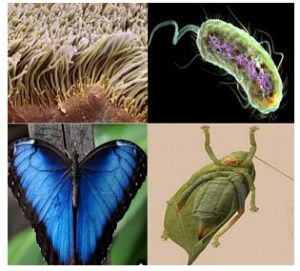Ass. Pro. Dr.: Israa Nasser Ghulam
Department of Biology
college of education for pure sciences
The invertebrate phylum is a very wide phylum that represents more than 97% of the total number of animals on earth. Because of these astronomical numbers, the means of movement of these organisms are varied from crawling and swimming to flying and hiding, and thus they show an impressive range of movement strategies. They arose by modifying the various structures of their bodies, including appendages and specialized organs for movement in accordance with the entire body plan. Understanding the diverse means of locomotion and locomotion in invertebrates offers valuable insights into their ecological adaptations.
Here are some of the organs of movement and their presence :
⦁ Ciliary and Flagellum Locomotion : It is used by low invertebrate organisms called protozoa , whose body consists of one cell, such as Paramecium and Euglena The only difference between the fringe and the whip is the way they strike the water, not the structure, as the two are similar internally . [1]
⦁ Pseudopodia and Amoeboid Movement : They are also found in protozoa , where the members of this group are characterized by multiple forms of pseudopodia , and they appear in amoeba and its group, and the movement is called the amoebic movement, in general, the members of this group are distinguished by their irregular shape. [2]
⦁ Hydrostatic Skeleton and adulatory Locomotion : They are found in some soft-bodied invertebrates and have a hydrostatic skeleton for locomotion. This system relies on fluid-filled body cavities and the contraction of the surrounding muscles. The movement occurs when the muscles contract, thus generating pressure on the fluid and causing the body to change its shape and push the sperm in its place. It includes many soft-bodied marine invertebrates, such as jellyfish and sea anemones. [3]
⦁ Setae and Chaetae : These structures are found in various types of worms, such as ringworms, tapeworms, and a wide spectrum of worms. In general, they have needle shapes of different sizes that help the worms in vermiform movement or more like crawling . [4].
⦁ Flight in Insects : They are found in various types of insects in general and arthropods, where their members move in different ways, once flying, once walking, and once swimming, and it may be due to the proportion of this category in relation to the percentage of the original invertebrates, as it constitutes approximately more than 79% of them.. [5].
Reffrence :
⦁ Lechtreck, K. F. (2015). IFT-Cargo Interactions and Protein Transport in Cilia. Trends in Biochemical Sciences, 40(12), 765-778.
⦁ Hohl, H. R., et al. (1980). Amoeboid movement in normal and abnormal cellular slime molds. Journal of Cell Biology, 86(2), 527-533.
⦁ Bennet-Clark, H. C. (1975). The efficiency of undulatory locomotion. Journal of Zoology, 176(4), 437-456.
⦁ Rouse, G. W., et al. (2018). Phylogeny and life history evolution of the tubeworm family Serpulidae (Annelida: Polychaeta). Cladistics, 34(3), 221-252 .
⦁ Wootton, R. J., et al. (1992). The Functional and Ecological Consequences of Flightlessness in Insects. In M. A. A. Venrooij (Ed.), Insects in Flight (pp. 209-236). Springer.
 University of Kerbala
University of Kerbala



























































